
LOADING ...
In response to evolving domestic opinion, eMedals Inc has made the conscious decision to remove the presentation of German Third Reich historical artifacts from our online catalogue. For three decades, eMedals Inc has made an effort to preserve history in all its forms. As historians and researchers, we have managed sensitive articles and materials with the greatest of care and respect for their past and present social context. We acknowledge the growing sentiments put forth by the Canadian public and have taken proactive actions to address this opinion.
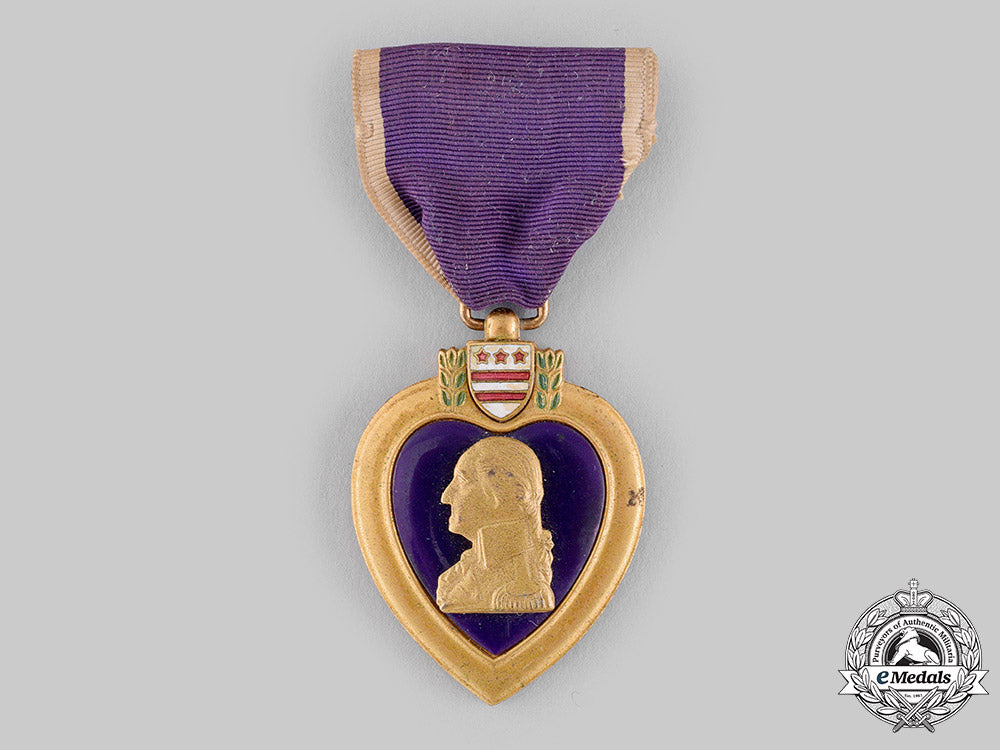
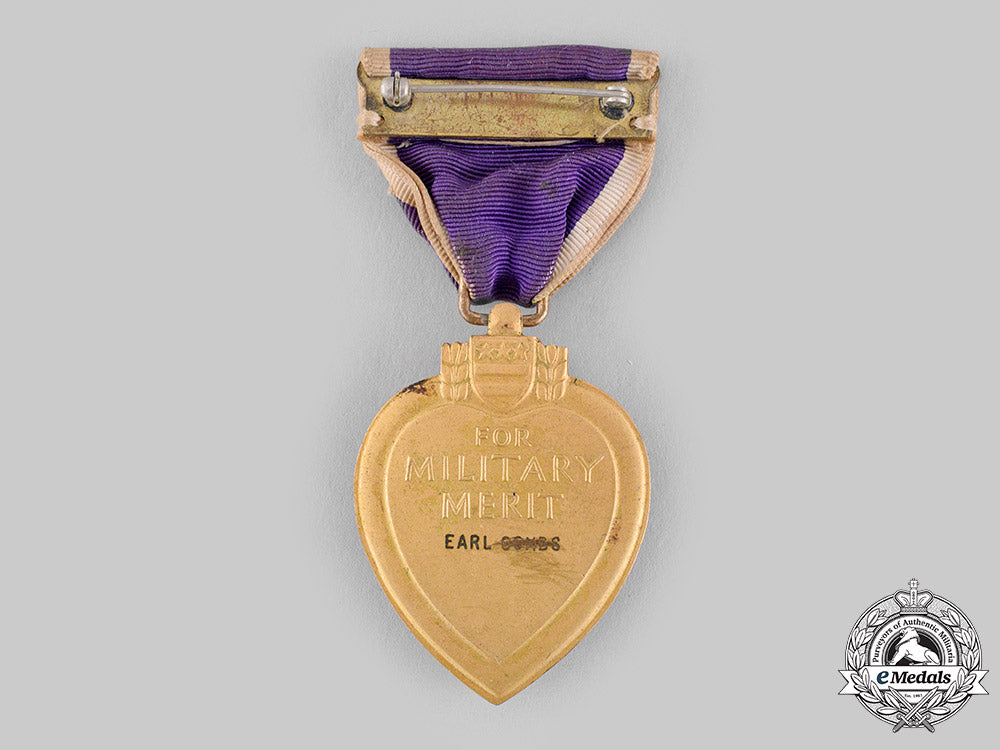
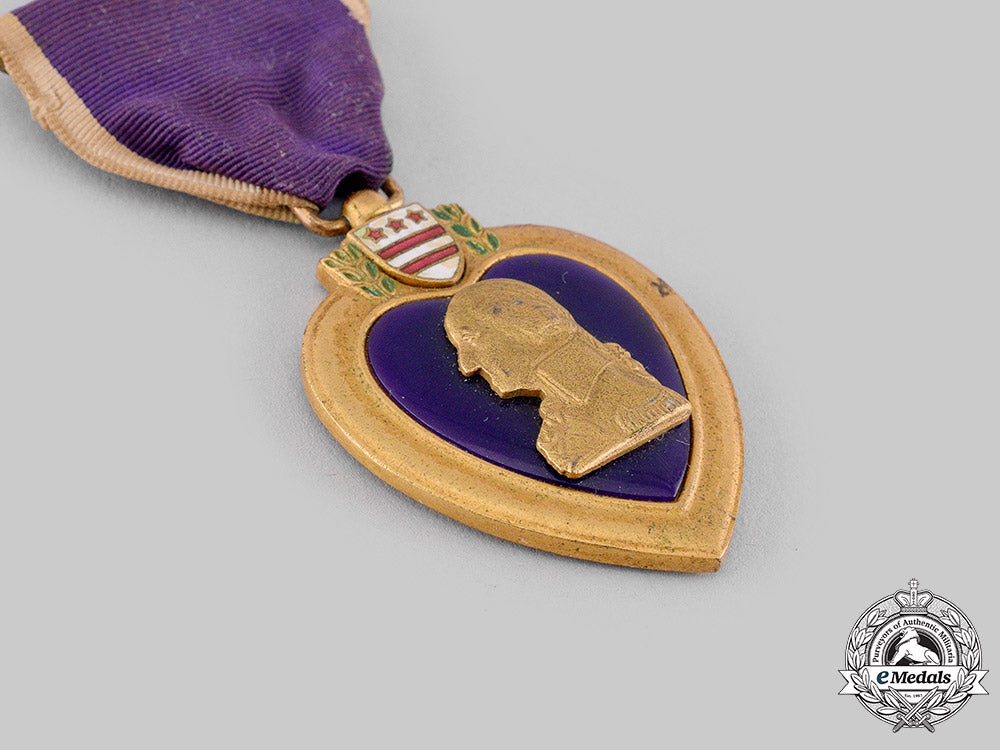
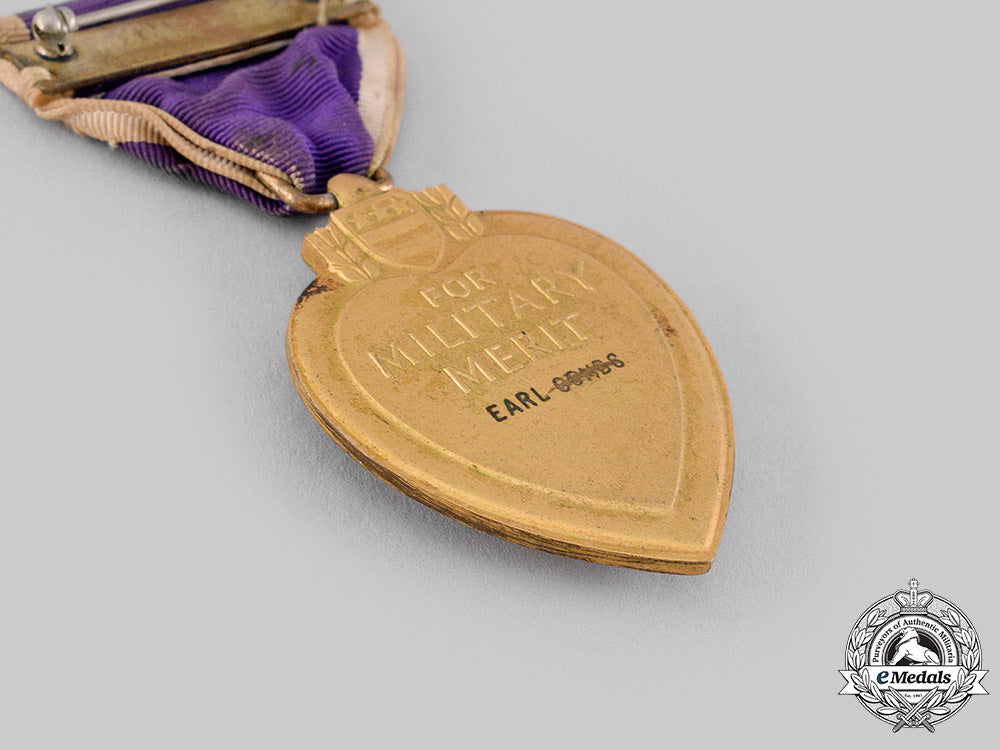
United States. A Purple Heart, 7Th Armored Division, Battle Of The Bulge 1944 Pow
United States. A Purple Heart, 7Th Armored Division, Battle Of The Bulge 1944 Pow
SKU: ITEM: W6133
Current Bid:
Your Max Bid:
Bid History:
Time Remaining:
Couldn't load pickup availability
Shipping Details
Shipping Details
eMedals offers rapid domestic and international shipping. Orders received prior to 12:00pm (EST) will be shipped on the same business day.* Orders placed on Canadian Federal holidays will be dispatched the subsequent business day. Courier tracking numbers are provided for all shipments. All items purchased from eMedals can be returned for a full monetary refund or merchandise credit, providing the criteria presented in our Terms & Conditions are met. *Please note that the addition of a COA may impact dispatch time.
Shipping Details
eMedals offers rapid domestic and international shipping. Orders received prior to 12:00pm (EST) will be shipped on the same business day.* Orders placed on Canadian Federal holidays will be dispatched the subsequent business day. Courier tracking numbers are provided for all shipments. All items purchased from eMedals can be returned for a full monetary refund or merchandise credit, providing the criteria presented in our Terms & Conditions are met. *Please note that the addition of a COA may impact dispatch time.
Description
Description
Two-piece construction, in bronze gilt with purple, red, white and green enamels, engraved "EARL COMBS" on the reverse, measuring 35 mm (w) x 43.5 mm (h), intact enamels, contact marks, scattered gilt wear, original ribbon with brooch pinback, fine. Accompanied by a duo-tang binder with assorted research papers.
Footnote: Earl Combs was serving with the 38th Armored Infantry Battalion, 7th Armored Division when he was in action during the Battle of St, Vith in Belgium, one of several battles constituting the opening of Germany's Ardennes counteroffensive (more commonly known as the "Battle of the Bulge"), when he was captured on December 21, 1944 and taken as a Prisoner of War.
In the After Action Report (AKA War Diary) filed by Lieutenant Colonel Marcus S. Griffin, Infantry, Commanding, it documents the events of the battle the day he was captured: "Just prior to 1100 hours on the 21st December 1944, the sector on our extreme right (B-23rd A.I.B. = Armored Infantry Battalion) was heavily shelled and at 1100 hours the enemy attacked this sector but were repelled. The attack was by infantry and no armor. Again at 1350, attacks took place this time by both tanks and infantry and the sectors held by A-23rd A.I.B. (N.E. of St.Vith) and B-23rd A.I.B. (S.E. of St. Vith) were the targets of the attack. Both these attacks were stopped but the continued pounding along our line weakened it some what and assistance was needed to strengthen these lines and hold for the night.
Even though the attacks were stopped, the artillery continued to give our positions heavy barrages. From 1530 hours until 1600 hours the barrage was shifted toward the center of our sector. At 1600 hours the heaviest artillery barrage the battalion had yet encountered landed on all of our positions and shifted back and forth from our front lines into St. Vith and back again. This barrage continued until about 1800 hours. 1610 hours found the enemy advancing on our most northeast sector (A-38th A.I.B.) and at 1615 hours he was advancing toward the center of our lines. By 1619 hours, German infantry was attacking along the entire sector and enemy artillery was hitting everywhere. The enemy infantry by itself did not make any penetration on our lines. German tanks started to appear and by 1635 hours our lines were receiving direct fire. The battalion had requested various artillery concentration but apparently enough artillery could not be brought to bear on the various targets. At 1700 hours, the attack seemed to have lost some of its impetus and our lines have held. Artillery however still dropped on our positions apparently from the direction of Wallerode. By 1715 hours it was apparent that the attack was starting again and this time at the direct center of our sector. Tanks attacked towards our O.P. (Offensive Position) and the officer in charge there practically begged for supports of tanks or TDs. At this time the sector to the northeast of St. Vith reported everything quiet, but in the southeast the attack continued. At 1730 hours this sector also stated that to hold they must have tank support. At 1735, the center of our sector reported enemy tanks again, and again asked that tanks be sent to his assistance, and at 1800 hours the sector to the northeast (A-38th A.I.B.) stated that his supporting tanks had withdrawn and that he must have them replaced.
By 1805, enemy tanks were firing point blank range from only 50 yards in front of our center sector (B-38th A.I.B.). The fighting continued but by 1844 hours, the attacks seemed to be temporarily stopped, although on our S.E. sector (B-23rd A.I.B) the situation was still critical. By 1905 hours, the artillery of the Germans was still pounding away and although B-23rd was adjusting their line, some infiltration had taken place. At 1914 hours, the C.O. (Commanding Officer) of B-23rd A.I.B. stated that he was still looking for tanks which were to come up for his support and that without them, the situation on his right flank is very serious. By 1935 hours tanks (enemy) were again approaching the sector held by A-38th (N.E. St. Vith) and by 1944, the other end of the line was receiving another heavy attack which resulted in the C.P. of B-23rd A.I.B. being out off. At 1950 hours, tanks coming to our support were located but apparently arrived too late to put them into position so as to support our line. At 2005 hours, German tanks had broken through the center of our line (between B-38th A.I.B. and the combat engineers attached to us). These tanks proceeded down the road toward St. Vith and overran the battalion forward C.P. By 2010, tanks had also broken through A-23rd A.I.B. and other German tanks were reported back of the positions held by A-38th.
General weakening of the line appeared at about 1800 hours. The German artillery barrage was extremely heavy and lack of our own was felt extremely. At about 2000 hours our entire line was bending and giving and breakthroughs of both tanks and infantry came about that time. The situation with both tanks and infantry between our lines and St. Vith, became very grave. At about 2130, the battalion C.P. (Command Position) was moved from St. Vith to the vicinity east of Krombach and there to a position northeast of Krombach where at 0900 hours on the 22nd December, the men, escaping back through and around St. Vith were organized and the battalion set up a defensive position N.E. of Krombach. The battalion C.P. was moved to Maldingen."
Having been taken as a Prisoner of War, Corporal Earl Combs was subsequently housed at Stalag 4B in Muhlberg, Saxony, Germany. He was released from captivity and returned to Military Control on June 29, 1945.
Description
Two-piece construction, in bronze gilt with purple, red, white and green enamels, engraved "EARL COMBS" on the reverse, measuring 35 mm (w) x 43.5 mm (h), intact enamels, contact marks, scattered gilt wear, original ribbon with brooch pinback, fine. Accompanied by a duo-tang binder with assorted research papers.
Footnote: Earl Combs was serving with the 38th Armored Infantry Battalion, 7th Armored Division when he was in action during the Battle of St, Vith in Belgium, one of several battles constituting the opening of Germany's Ardennes counteroffensive (more commonly known as the "Battle of the Bulge"), when he was captured on December 21, 1944 and taken as a Prisoner of War.
In the After Action Report (AKA War Diary) filed by Lieutenant Colonel Marcus S. Griffin, Infantry, Commanding, it documents the events of the battle the day he was captured: "Just prior to 1100 hours on the 21st December 1944, the sector on our extreme right (B-23rd A.I.B. = Armored Infantry Battalion) was heavily shelled and at 1100 hours the enemy attacked this sector but were repelled. The attack was by infantry and no armor. Again at 1350, attacks took place this time by both tanks and infantry and the sectors held by A-23rd A.I.B. (N.E. of St.Vith) and B-23rd A.I.B. (S.E. of St. Vith) were the targets of the attack. Both these attacks were stopped but the continued pounding along our line weakened it some what and assistance was needed to strengthen these lines and hold for the night.
Even though the attacks were stopped, the artillery continued to give our positions heavy barrages. From 1530 hours until 1600 hours the barrage was shifted toward the center of our sector. At 1600 hours the heaviest artillery barrage the battalion had yet encountered landed on all of our positions and shifted back and forth from our front lines into St. Vith and back again. This barrage continued until about 1800 hours. 1610 hours found the enemy advancing on our most northeast sector (A-38th A.I.B.) and at 1615 hours he was advancing toward the center of our lines. By 1619 hours, German infantry was attacking along the entire sector and enemy artillery was hitting everywhere. The enemy infantry by itself did not make any penetration on our lines. German tanks started to appear and by 1635 hours our lines were receiving direct fire. The battalion had requested various artillery concentration but apparently enough artillery could not be brought to bear on the various targets. At 1700 hours, the attack seemed to have lost some of its impetus and our lines have held. Artillery however still dropped on our positions apparently from the direction of Wallerode. By 1715 hours it was apparent that the attack was starting again and this time at the direct center of our sector. Tanks attacked towards our O.P. (Offensive Position) and the officer in charge there practically begged for supports of tanks or TDs. At this time the sector to the northeast of St. Vith reported everything quiet, but in the southeast the attack continued. At 1730 hours this sector also stated that to hold they must have tank support. At 1735, the center of our sector reported enemy tanks again, and again asked that tanks be sent to his assistance, and at 1800 hours the sector to the northeast (A-38th A.I.B.) stated that his supporting tanks had withdrawn and that he must have them replaced.
By 1805, enemy tanks were firing point blank range from only 50 yards in front of our center sector (B-38th A.I.B.). The fighting continued but by 1844 hours, the attacks seemed to be temporarily stopped, although on our S.E. sector (B-23rd A.I.B) the situation was still critical. By 1905 hours, the artillery of the Germans was still pounding away and although B-23rd was adjusting their line, some infiltration had taken place. At 1914 hours, the C.O. (Commanding Officer) of B-23rd A.I.B. stated that he was still looking for tanks which were to come up for his support and that without them, the situation on his right flank is very serious. By 1935 hours tanks (enemy) were again approaching the sector held by A-38th (N.E. St. Vith) and by 1944, the other end of the line was receiving another heavy attack which resulted in the C.P. of B-23rd A.I.B. being out off. At 1950 hours, tanks coming to our support were located but apparently arrived too late to put them into position so as to support our line. At 2005 hours, German tanks had broken through the center of our line (between B-38th A.I.B. and the combat engineers attached to us). These tanks proceeded down the road toward St. Vith and overran the battalion forward C.P. By 2010, tanks had also broken through A-23rd A.I.B. and other German tanks were reported back of the positions held by A-38th.
General weakening of the line appeared at about 1800 hours. The German artillery barrage was extremely heavy and lack of our own was felt extremely. At about 2000 hours our entire line was bending and giving and breakthroughs of both tanks and infantry came about that time. The situation with both tanks and infantry between our lines and St. Vith, became very grave. At about 2130, the battalion C.P. (Command Position) was moved from St. Vith to the vicinity east of Krombach and there to a position northeast of Krombach where at 0900 hours on the 22nd December, the men, escaping back through and around St. Vith were organized and the battalion set up a defensive position N.E. of Krombach. The battalion C.P. was moved to Maldingen."
Having been taken as a Prisoner of War, Corporal Earl Combs was subsequently housed at Stalag 4B in Muhlberg, Saxony, Germany. He was released from captivity and returned to Military Control on June 29, 1945.



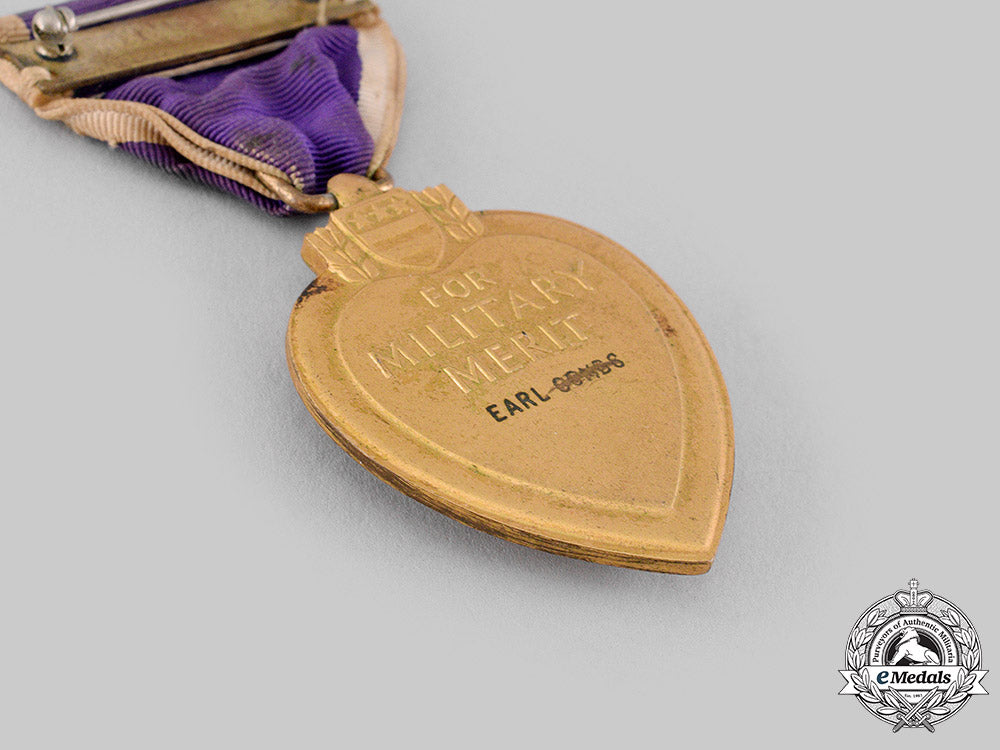
You May Also Like
Germany, SA. A Model 1933 Service Dagger, SA-Gruppe Nordsee, by Friedrich von der Kohlen
G59818
Germany, SA. A Model 1933 Service Dagger, SA-Gruppe Pommern, by Gustav Wirth
G59816
Germany, Third Reich. A Mixed Lot of Tyrolean Marksmanship Badges
G52930
Germany, SS. An Estonian Waffen-SS Volunteer’s Sleeve Shield
G50381
Germany, SS. A Waffen-SS Sturmmann Sleeve Insignia
G52846
-
Germany, SA. A Model 1933 Service Dagger, SA-Gruppe Nordsee, by Friedrich von der Kohlen
G59818
Add to CartRegular price $980 USDRegular price $0 USD Sale price $980 USDUnit price / per -
Germany, SA. A Model 1933 Service Dagger, SA-Gruppe Pommern, by Gustav Wirth
G59816
Add to CartRegular price $980 USDRegular price $0 USD Sale price $980 USDUnit price / per -
Germany, Third Reich. A Mixed Lot of Tyrolean Marksmanship Badges
G52930
Add to CartRegular price $135 USDRegular price $0 USD Sale price $135 USDUnit price / per -
Germany, SS. An Estonian Waffen-SS Volunteer’s Sleeve Shield
G50381
Add to CartRegular price $150 USDRegular price $0 USD Sale price $150 USDUnit price / per -
Germany, SS. A Waffen-SS Sturmmann Sleeve Insignia
G52846
Add to CartRegular price $135 USDRegular price $0 USD Sale price $135 USDUnit price / per
Do you have a similar item you are interested in selling?
Please complete the form and our client care representatives will contact you.
Sell Item












